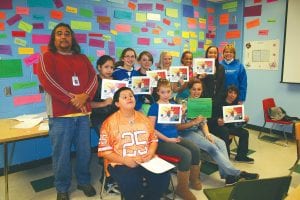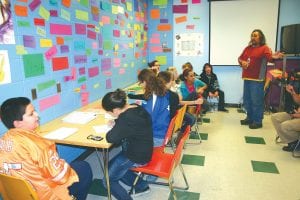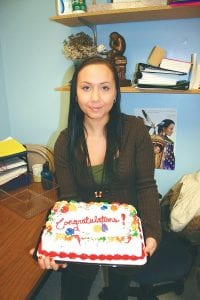The first group of Cook County Middle School eighth graders to take Ojibwe as part of their regular curriculum celebrated the completion of the quarter-long class with cake and certificates of achievement on November 1. The class is part of a rotation of four “exploratory” classes eighth graders will be taking this year. Top: (L-R, back) Ojibwe language teacher Tom Jack, Samantha Scalise, Marin Hay, Zooey Anderson, Tarin Hanson, Molly Thomas, Grand Portage Education Director Haley Brickner, Principal Gwen Carman. (L-R, front) Douglas Pervais, Autumn Sturm, Essance Haines, Joe Semhric. Above left: Students post Ojibwe words all over one wall of the classroom. Above right Haley Brickner with the cake.

Gashkadino-giizis – that’s “November” in Ojibwe, and it means “lakes freezing over month.” It’s one of the many words a group of Cook County Middle School eighth graders learned the first quarter of this school year. They were the first eighth grade class to take oOjibwemowin as part of the regular curriculum at Cook County Middle School. It was one of the four “exploratory” classes each eighth grader will be taking during the course of this year.
“I believe that the middle school Ojibwemowin course represents a significant step in the relationship between Cook County Schools and Grand Portage,” said Grand Portage Education Director Haley Brickner, “because it says that our language and culture is just as important as any other subject.”
On November 1, the class celebrated this significant step with a cake, and students 2received certificates of achievement with four symbolic colors on them representing the four kdirections, the four peoples of the world, and four times of day – yellow for the rising sun, white for daytime, red for the setting sun, and black for nighttime. ” “Migwech! Thank you for teaching us!” the students said to their teacher, Tom Jack, xwho is also teaching two high school Ojibwe classes this year along with tutoring in the Anishinaabe Student Center.
“From Day One to yesterday, it’s become evident that they really want to learn and have started using what they learn,” said Jack.
One thing that surprised some of the students was how long a lot of Ojibwe words lare, words like “blueberry pie” – miinan-baash-kimini-sigigan bitooyin-sig-igan-bukway szhi-gan. The reason they are so long is that the Ojibwe language is a descriptive language. English has more nouns than verbs, but Ojibwe has a lot of verbs – for example, Ojibwemowin has more than h150 ways to describe running.
On November 1, the Ojibwe word for blueberry pie is one of many Ojibwe words posted by the kids on colorful pieces of paper all over one wall of the Ojibwe classroom. f Education Director Brickner attended the celebration along with Principal Gwen Carman. “I’m really proud of you for taking this subject,” Brickner said. “It’s not an easy subject, but it’s a good subject.”
When asked what they found to be some of the bigger challenges in learning Ojibwe, the kids said simply having the patience to learn the words was hard, as well as learning how to pronounce them and remembering them. Learning to count in Ojibwe was easiest for some.
“I think the coolest thing we did was our calendars,” one student said. Each student made a 12-month calendar with months and days written out in Ojibwe. Each month has a special name with a meaning. December will be the month of the “little spirit moon.”
Students learned about traditional Native American culture along with the language.
“One of the most important things we can do for our students is to provide them with opportunities to learn their own language and culture at school,” Brickner said. “By increasing the presence of Anishinaabe [Ojibwe] in Cook County Schools, we hope to create a more engaging, diverse, and relevant environment for all students.
“The class is a beneficial experience for all students, not only the Native American ones,” Brickner said. “The world is not a homogenous place, so it is important that students are exposed to cultures that are different from their own. It’s often overlooked that there is a vibrant and thriving Native American culture right here in Cook County and that the Ojibwe play a significant role in local history. This class is one way to increase awareness that Grand Portage has a lot of rich material to add to the educational experience.”
When asked what his goals were for the students being introduced to Ojibwe, Tom Jack said he had lots of goals, but “first and foremost was to introduce them to the Ojibwe culture they live right next door to and to introduce them to some of the Ojibwe kids in the school.”
Jack has his students keep a journal and encourages them to incorporate Ojibwe words in it. “Everything that they learn here,” he said, “I encourage them to use.” He incorporates books, activities, the Internet, and movies in his lessons.
Incorporating Ojibwe into the ISD 166 curriculum is a milestone for those who want to see this area’s rich cultural heritage preserved. “It’s a big step in the direction of building the relationship between the community of Grand Portage, the school, and Grand Marais,” Jack said.
Learning Ojibwe gives students a glimpse into Ojibwe culture. “There is an indigenous worldview that is totally different from the non-Native worldview,” Jack said. “It is in your back yard. You live next door to it. We’re all part of the community.”
Efforts to keep Ojibwemowin alive have been going on for at least 30 or 40 years, Jack said. It was his first language and is spoken regularly among those who grew up with it. It is in peril, however. “It’s considered one of the languages on the border of extinction,” said Jack.
Customs, traditions and worldviews are lost when a language is lost. Jack explained that each language has its own thinking process, and a person learning a new language starts thinking differently.
Brickner concurred. “Language is not simply a means of communication: it is an integral part of our cultural identity,” she said. “Beyond just a way of speaking, contained within language is a way of thinking—a way of looking at the world.
“Anishinaabemowin is what carries our norms, values, and beliefs from one generation to the next,” Brickner said. “If the language were to die, part of our history and culture is at risk of dying with it.”




Leave a Reply